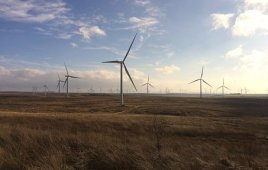This article comes from Wilmer Cutler Pickering Hale and Dorr LLP and is authored by Michael J.P. Hazel, Raya B. Treiser and Sarah C. Judkins
The United States Court of Appeals for the Tenth Circuit recently held that excavation work performed by a private company when installing wind turbines constituted “mining” under the federal regulation governing mineral development on tribal land. This is an interesting and noteworthy decision for anyone involved in developing energy projects (both renewable and conventional) on tribal lands.
Background
The Osage Nation reservation in Oklahoma was established in the late nineteenth century. Congress subsequently severed the mineral estate—which is held in trust by the United States for the benefit of the tribe—from the surface estate—which was allotted to individual tribe members. The dispute in this case arose when Osage Wind, a private company, leased surface rights to construct an 84-turbine commercial wind farm on the Osage Nation reservation. To create the foundations for the turbines, Osage Wind excavated soil, sand, and rocks. The smaller rocks were then crushed and used as backfill for the foundations.
The United States government filed suit, alleging that Osage Wind’s excavation activities constituted “mining” under the federal regulations that govern the leasing of tribal lands for mineral development. In particular, 25 C.F.R. § 211.3 defines “mining” as “the science, technique, and business of mineral development, including, but not limited to: opencast work, underground work, and in-situ leaching directed to severance and treatment of minerals.” As a result, the United States argued, Osage Wind was required to obtain a separate lease—approved by the tribe and the federal government—authorizing such mining.
The district court disagreed that the excavation work qualified as “mining” and granted summary judgment for Osage Wind. After learning that the United States would not pursue an appeal, the Osage Mineral Council, acting on behalf of the Osage Nation, filed a last-minute appeal to the Tenth Circuit.
Circuit Court Decision
The Tenth Circuit reversed the district court, holding that Osage Wind’s excavation activities did constitute “mining” under § 211.3. In doing so, the court rejected the argument that mining necessarily involves the sale or offsite relocation of minerals. Instead, the court gave the regulatory language a broader interpretation: mining includes any “action upon the minerals in order to exploit the minerals themselves.”
Although the court clarified that this definition would not encompass “merely encountering or incidentally disrupting mineral materials,” that is not all Osage Wind had done: it had “sorted the rocks, crushed the rocks into smaller pieces, and then exploited the crushed rocks as structural support for each wind turbine.” This manipulation and use of the excavated minerals, in the court’s view, was sufficient to bring the activity within the definition of mining.
Important to the court’s conclusion was the “long-standing principle” that ambiguous language in laws designed to favor tribes should be “liberally construed” in the tribes’ favor (often referred to as the “Indian canon of construction”). After determining that the regulatory definition of “mining” was ambiguous, the court adopted an expansive interpretation that favored the Osage Nation—even while acknowledging that Osage Wind’s activity “does not fit nicely with traditional notions of ‘mining,’” and “surface construction for a wind farm is a far cry from a typical mining operation.”
Potential Implications
This decision has the potential for significant implications for future development of energy projects on tribal lands. The regulation at issue—the definition of “mining” in 25 C.F.R. § 211.3—has general application to all leases and permits for the development of tribal mineral resources, including oil and gas, coal, geothermal, and solid minerals. And the court, by its own admission, has expanded the range of activities that are considered “mining” beyond how that term is “commonly understood.” It is also worth noting that the same definition of “mining” is used in regulations governing the leasing of allotted lands for mineral development (25 C.F.R. § 212.3), and the court’s reasoning could be applied to that context as well.
There are, however, factors that could limit this decision’s real-world impact. For starters, it is only binding in the Tenth Circuit, which encompasses Colorado, Kansas, New Mexico, Oklahoma, Utah, and Wyoming. There are substantial tribal lands, however, in other states—for example, California, Arizona, Washington, and Montana, all of which are in the Ninth Circuit. Depending on how courts in other circuits handle this issue (if and when it is presented), projects on reservations in those states could be unaffected.
In addition, the result of this case turned not only on the general definition of mining in § 211.3, but also on a regulation specific to the Osage Nation (25 C.F.R. § 214.7), which prohibits mining on the tribe’s land without obtaining a lease approved by the Secretary of the Interior. Developers on tribal lands should therefore carefully review relevant regulations to check for similar leasing requirements for mineral development.
This case signals that, especially where tribal lands and interests are involved, courts are unlikely to be sympathetic to a company’s failure to obtain all necessary approvals before commencing a large-scale project, and it serves as a useful reminder to project developers to be proactive and stay abreast of changing legal interpretations and requirements.
Filed Under: Construction





